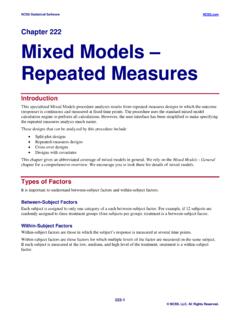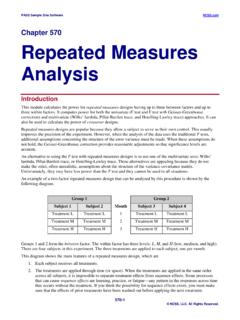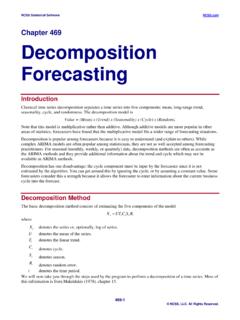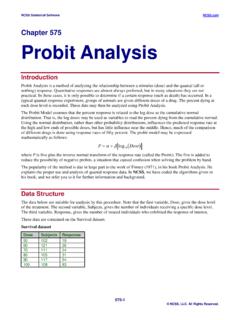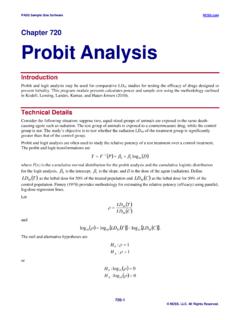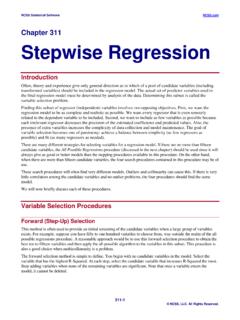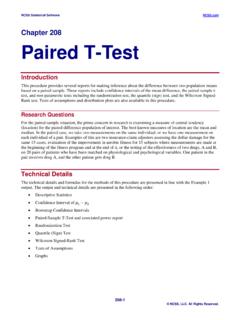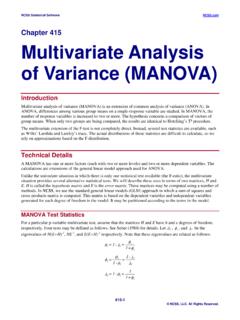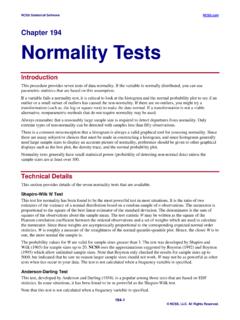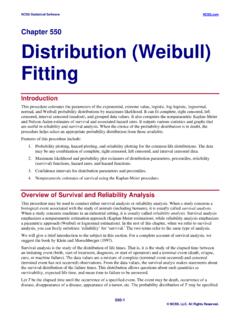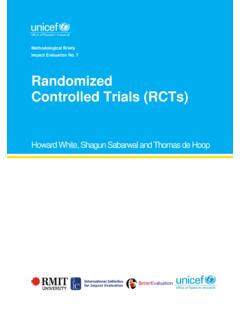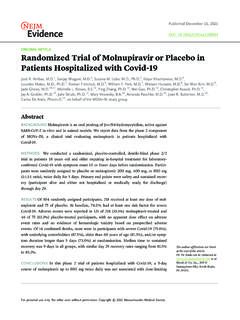Transcription of Randomized Block Analysis of Variance - NCSS
1 PASS Sample Size Software 565-1 NCSS, LLC. All Rights Reserved. Chapter 565 Randomized Block Analysis of Variance Introduction This module analyzes a Randomized Block Analysis of Variance with up to two treatment factors and their interaction. It provides tables of power values for various configurations of the Randomized Block design. The Randomized Block Design The Randomized Block design (RBD) may be used when a researcher wants to reduce the experimental error among observations of the same treatment by accounting for the differences among blocks. If three treatments are arranged in two blocks, the RBD might appear as follows: Block A Block B Treatment 1 Treatment 2 Treatment 3 Treatment 1 Treatment 2 Treatment 3 This diagram shows the main features of an RBD: 1. Each Block is divided into k sub-blocks, where k is the number of treatments.
2 2. Each Block receives all the treatments. 3. The treatments are assigned to the sub-blocks in random order. 4. There is some reason to believe that the blocks are the same internally, but different from each other. RBD Reduces Random Error The random error component of a completely Randomized design (such as a one-way or a fixed-effects factorial design) represents the influence of all possible variables in the universe on the response except for the controlled (treatment) variables. This random error component is called the standard deviation or (sigma). As we have discussed, the sample size required to meet alpha and beta error requirements depends directly on the standard deviation. As the standard deviation increases, the sample size increases. Hence, researchers are always looking for ways to reduce the standard deviation.
3 Since the random error component contains the variation due to all possible variables other than treatment variables, one of the most obvious ways to reduce the standard deviation is to remove one or more of these nuisance variables from the random error component. One of the simplest ways of doing this is by blocking on them. For example, an agricultural experiment is often blocked on fields so that differences among fields are explicitly accounted for and removed from the error component. Since these field differences are caused by PASS Sample Size Software Randomized Block Analysis of Variance 565-2 NCSS, LLC. All Rights Reserved. variations in variables such as soil type, sunlight, temperature, and water, blocking on fields removes the influence of several variables. Blocks are constructed so that the response is as alike (homogeneous) as possible within a Block , but as different as possible between blocks.
4 In many situations, there are obvious natural blocking factors such as schools, seasons, individual farms, families, times of day, etc. In other situations, the blocks may be somewhat artificially constructed. Once the blocks are defined, they are divided into k smaller sections called subblocks, where k is the number of treatment levels. The k treatments are randomly assigned to the subblocks, one Block at a time. Hence the order of treatment application will be different from Block to Block . Measurement of Random Error The measurement of the random error component ( ) is based on the assumption that there is no fundamental relationship between the treatment variable and the blocking variable. When this is true, the interaction component between blocks and treatment is zero. If the interaction component is zero, then the amount measured by the interaction is actually random error and can be used as an estimate of.
5 Hence, the Randomized Block design makes the assumption that there is no interaction between treatments and blocks. The Block by treatment mean square is still calculated, but it is used as the estimated standard deviation. This means that the degrees of freedom associated with the Block -treatment interaction are the degrees of freedom of the error estimate. If the experimental design has k treatments and b blocks, the interaction degrees of freedom are equal to (k-1)(b-1). Hence the sample size of this type of experiment is measured in terms of the number of blocks. Treatment Effects Either one or two treatment variables may be specified. If two are used, their interaction may also be measured. The null hypothesis in the F test states that the effects of the treatment variable are zero. The magnitude of the alternative hypothesis is represented as the size of the standard deviation ( m) of these effects.
6 The larger the size of the effects, the larger their standard deviation. When there are two factors, the Block -treatment interaction may be partitioned just as the treatment may be partitioned. For example, if we let C and D represent two treatments, an Analysis of Variance will include the terms C, D, and CD. If we represent the blocking factor as B, there will be three interactions with blocks: BC, BD, and BCD. Since all three of these terms are assumed to measure the random error, the overall estimate of random error is found by averaging (or pooling) these three interactions. The pooling of these interactions increases the power of the experiment by effectively increasing the sample size on which the estimate of is based. However, it is based on the assumption that = = = , which may or may not be true.
7 PASS Sample Size Software Randomized Block Analysis of Variance 565-3 NCSS, LLC. All Rights Reserved. An Example Following is an example of data from a Randomized Block design. The Block factor has four blocks (B1, B2, B3, B4) while the treatment factor has three levels (low, medium, and high). The response is shown within the table. Randomized Block Example Treatments Blocks Low Medium High B1 16 19 20 B2 18 20 21 B3 15 17 22 B4 14 17 19 Analysis of Variance Hypotheses The F test for treatments in a Randomized Block design tests the hypothesis that the treatment effects are zero. (See the beginning of the Fixed-Effects Analysis of Variance chapter for a discussion of the meaning of effects.) Single-Factor Repeated Measures Designs The Randomized Block design is often confused with a single-factor repeated measures design because the Analysis of each is similar.
8 However, the randomization pattern is different. In a Randomized Block design, the treatments are applied in random order within each Block . In a repeated measures design, however, the treatments are usually applied in the same order through time. You should not mix the two. If you are analyzing a repeated measures design, we suggest that you use that module of PASS to do the sample size and power calculations. PASS Sample Size Software Randomized Block Analysis of Variance 565-4 NCSS, LLC. All Rights Reserved. Example 1 Power after a Study This example will explain how to calculate the power of F tests from data that have already been collected and analyzed. We will analyze the power of the experiment that was given at the beginning of this chapter. These data were analyzed using the Analysis of Variance procedure in NCSS and the following results were obtained.
9 Analysis of Variance Table Source Sum of Mean Prob Power Term DF Squares Square F-Ratio Level (Alpha= ) A: Blocks 3 B: Treatment 2 * AB 6 S 0 0 Total (Adjusted) 11 Total 12 * Term significant at alpha = Means and Standard Error Section Standard Term Count Mean Error Effect B: Treatment High 4 Low 4 Medium 4 We will now calculate the power of the F test.
10 Note that factor B in this printout becomes factor A on the PASS input. To analyze these data, we enter the means for factor A. The value of is estimated as the square root of the mean square error: = PASS Sample Size Software Randomized Block Analysis of Variance 565-5 NCSS, LLC. All Rights Reserved. Setup If the procedure window is not already open, use the PASS Home window to open it. The parameters for this example are listed below and are stored in the Example 1 settings file. To load these settings to the procedure window, click Open Example Settings File in the Help Center or File menu. Design Tab _____ _____ Solve For .. Power Alpha for All Terms .. Number of Factors .. 1 A - Levels .. 3 A - Means .. List of Means A - List of Means .. ( Block -Treatment Interaction) .. Number of Blocks.
